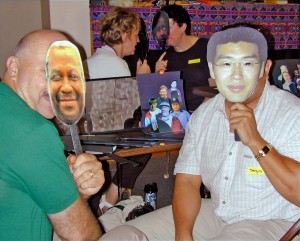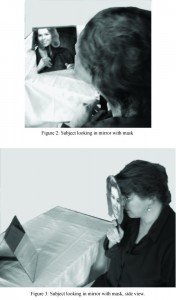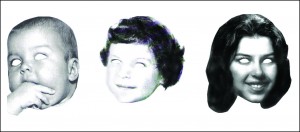Every program and innovation I have created has it’s own story. Here are brief chronicles for three of my inventions . . .
FACES IN THE CROWD
Faces in the Crowd refers to a series of art-based tools and programs that I developed over a period of years.
that I developed over a period of years.
The concept for the first tool, from which all others evolved, was born from experiences I had as a young person in which I became aware of the dimensions of class, race, and gender (see “My story”); a personal experience in which I discovered that I had made very incorrect assumptions about another person; and sketching my experiences in my journals.
For the first Faces in the Crowd tool, I made masks from photographs that I took of people from 75 countries of the world. I made “pop-up” pages that depicted a crowd of people that had one feature in common, such as their age, race, gender, clothing, body type, etc.
The pop-up pages flanked a central mirror. Participants looked in the mirror at their masked selves and got a sense of what it felt like to be a different person encountering the “crowds” in the pop-up pages. The participants then told their stories in the first person about their masked identity to each other.
One amazing result was that from workshop to workshop, individuals who had the same mask would create similar stories about their masked identity. Participants even gave their masks the same “name” as individuals had in previous workshops. Participants using this tool in the workshops make many curious discoveries about their thinking patterns, beliefs and assumptions.
SELF PORTRAIT
Since the Faces in the Crowd tool involved “access to others” through exercises that explored people’s projections and the reality concerning how others actually felt, I began to think “inwardly” and wished to gain improved access to my own self – my feelings, thoughts, and beliefs. This led to a series of programs and inventions dealing with the “self,” identity, and transformation.
I researched readings on the “self” and came across a concept that the self is a “negotiation between who you are and who your society allows you to be.” I began sketching what this phrase meant to me, and “invented” a new tool, which I called Self Portrait.
This tool consisted of a kind of portfolio booklet with three panels. The middle panel held acetate sleeves, each containing a separate photograph that depicted an individual at different ages. The two panels that flanked the middle one held acetate sheets. The left side acetate sheets were labeled “how I see myself” and the right side sheets were labeled “how others see me.” The acetate sheets were meant to be slid over onto the center photographs, one by one, and the individual depicted would write words descriptions and labels on the acetate sheets that described how he saw himself and others saw him at the different ages. At the end, all the acetate sheets would be piled up on the last photograph, and the individual would have a tangible “picture” for how the words, labels and descriptions he applied and others applied to him self across his life both defined and obscured who he was. The final step in the process was for the individual to “edit” out labels and descriptions he didn’t agree with, and to add whatever new ones he chose, to define his future self. I presented my Self Portrait program at the Gandhi Institute and with several adult and youth groups with much success. Individuals could gain insight into how their “self” formed from birth to the present day.
 MASKS, MIRRORS & ME
MASKS, MIRRORS & ME
One day, when reflecting on the Self Portrait tool, I suddenly had a brainstorm. I realized that the age-sequenced photographs in the “Self Portrait” portfolios could be made into masks similar to my Faces in the Crowd tool. This was the leap I had been looking for. I theorized that with age-sequenced self portrait photographic masks, an individual could explore aspects of his or her self that were more personal than with the photographs seen “objectively” in the portfolio. I hoped that such a tool could help individuals “access” themselves in such a powerful way, and that this self awareness would help them remember what it was like to be a child, and therefore, become better, more effective and empathetic parents. I had come full  circle, back to searching for solutions to my original goal from years before. I conducted a research study with human subjects using this tool as part of my final thesis project for graduate school. One of the results of this study was that the participants reported that using this tool in a facilitated session, was effective in helping them work through some current day issues they faced.
circle, back to searching for solutions to my original goal from years before. I conducted a research study with human subjects using this tool as part of my final thesis project for graduate school. One of the results of this study was that the participants reported that using this tool in a facilitated session, was effective in helping them work through some current day issues they faced.
